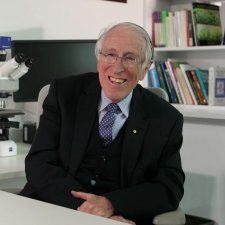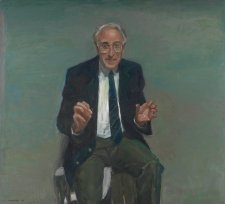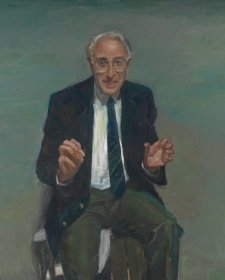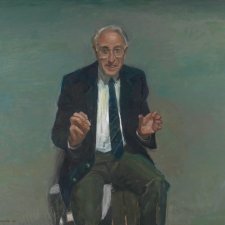Graeme Clark AO (b. 1935) is Laureate Professor Emeritus of Otolaryngology at the University of Melbourne and the Director Emeritus of the Bionic Ear Institute. Clark made it possible for thousands of profoundly deaf people to hear when he launched the cochlear implant in 1978. The possibility of using an electrical device to stimulate the nerves inside the inner ear to produce hearing had been pursued sporadically by researchers since the eighteenth century. Clark discovered how to insert an electrode into the inner ear while studying shells on the beach; it took him and his team twelve years to develop the first device that could do this successfully. Nicknamed the 'Bionic Ear', it remains the world leader in its field. Research and refinement of the cochlear implant continue, and Clark has also developed other hearing devices, in pursuit of what has been called one of the major medical advances of our time.
Peter Wegner painted this work for the 2000 Archibald Prize, having seen a photograph of Clark – with his 'warm and welcoming smile' – in an article about the bionic ear. Wegner's portrait shows Clark holding the prototype of the bionic ear, his open-handed gesture reflecting his years as a surgeon as well as his engaged and animated style of conversation.
Gift of the family of Professor Graeme Clark 2001. Donated through the Australian Government's Cultural Gifts Program.
© Peter Wegner
This portrait by Peter Wegner of Professor Graeme Clark was painted in 2000 in oils and on canvas. It measures 155.5 cm by 167.5 cm. The canvas sits within a 5 cm deep and 1 cm wide wooden frame which is painted distressed white gold.
Professor Clark, notable for inventing the cochlear implant, is seated in the centre of a flat empty space of wavy brush strokes, predominantly sea-green, with blue, pink and beige brushwork layered throughout.
Clark is facing forwards; his balding, long oval-shaped head is framed by thinning silver grey hair and cut above his ears. His is a man in his 60s with an even and lightly-bronzed complexion. A dash of light bounces off his high forehead suggesting the light source is central and slightly from our right. He wears large metallic thin-framed glasses which perch on his nose below his eyebrows and encompass his upper cheeks. Arched thin dark eyebrows are raised above Clark’s brown eyes which look off to our lower left as if in animated conversation. His nose is long and narrow, it bends towards our left, casting a shadow over his thin upper lip. His mouth is raised on our left into an open slightly sideways smile revealing his even upper teeth.
Leaning slightly forward, Clark wears a broad-shouldered navy-blue jacket, a white collared shirt and a contrasting dark-blue tie with diagonal light-green lines, there is a small indistinct oval shape between each of the diagonal stripes. With both arms bent at the elbow he lifts up both his hands in an open clasping position. In his right hand he is presenting a small rectangular shape with a wire. The other hand also held up and facing forward, is open and empty.
Clark wears pea-green trousers, his right knee is bent lower than his left. While indistinct, he appears to be sitting on a dark-brown wooden panel box, with a suggestion of white fabric under his right thigh. His portrait is cropped below his right knee and at the mid-calf point of his left.
Audio description written and voiced by Annette Twyman
Family Trust of Professor Graeme Clark (1 portrait)



On one level The Companion talks about the most famous and frontline Australians, but on another it tells us about ourselves.



Creator of the bionic ear, the Cochlear Implant, Professor Graeme Clark discusses his life and career.



Peter Wegner's approach to portraiture could be considered a visual record of the rapport, the dynamic space between artist and subject.